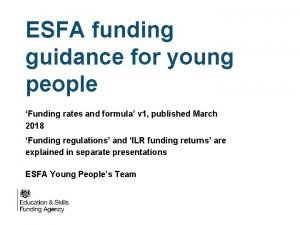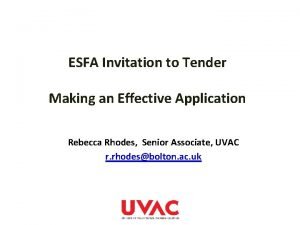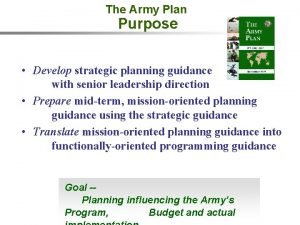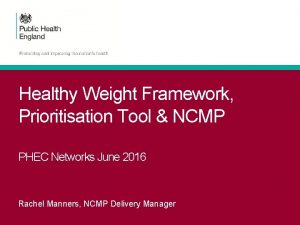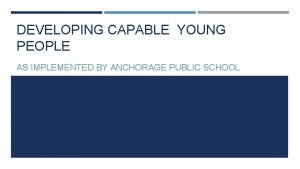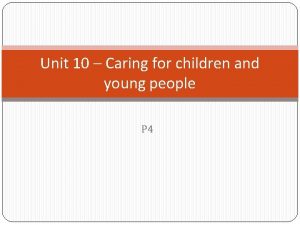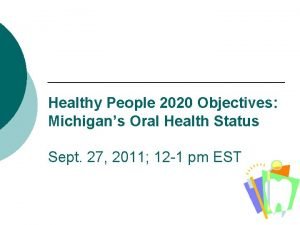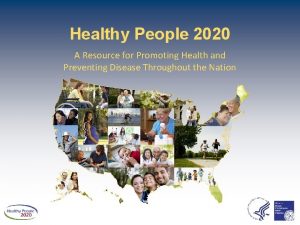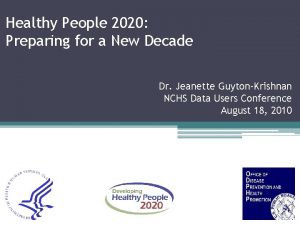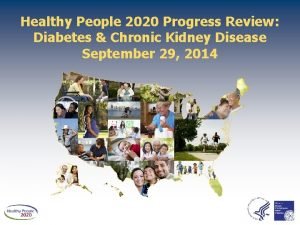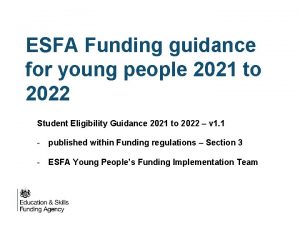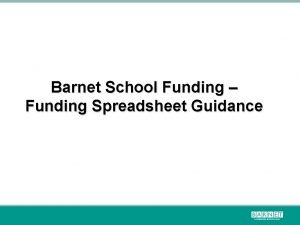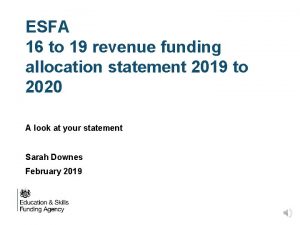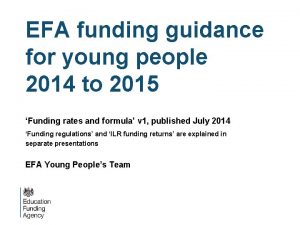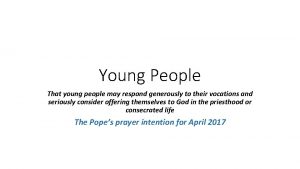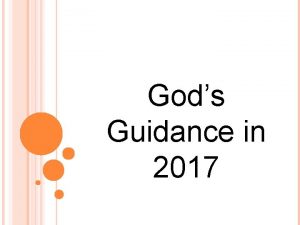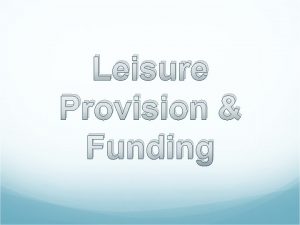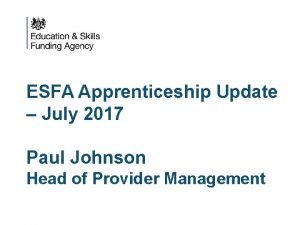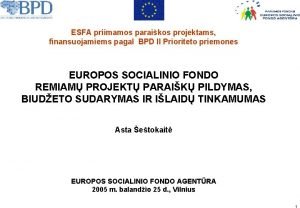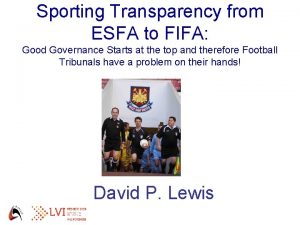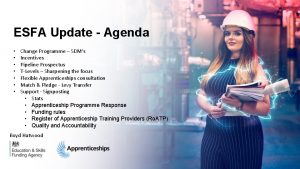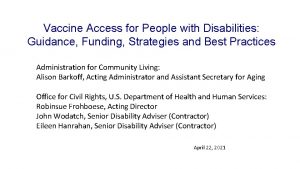ESFA funding guidance for young people 2020 to

























































- Slides: 57

ESFA funding guidance for young people 2020 to 2022 • Funding regulations 2020 to 2021 and 2021 to 2022 • Funding regulations – section 3: student eligibility is explained in a separate presentation • Subcontracting rules explained in a separate presentation ESFA Young People’s Funding Team

Funding guidance for young people: 2020 to 2021 and 2021 to 2022 2 Format similar to previous years. It consists of 4 separate books: • ‘Funding regulations’ (published May 2020 and January 2021) • ‘Funding rates and formula’ (published March 2020) • ‘ILR funding returns’ (published July 2020) – this does not apply to schools or academies • Subcontracting funding rules for ESFA funded post-16 funding (excluding apprenticeships) All these documents are available at: www. gov. uk/16 -to-19 -educationfunding-guidance

Regulations What’s new for 2020 to 2021 and 2020 to 2022 • Student eligibility advice for 2020 to 2021 is updated for UK exit from EU – see paragraphs 28 to 31 • Student eligibility advice for 2021 to 2022 is updated for UK exit from EU – see paragraphs 28 to 31 • Advice updated for both years to take into account pandemic impacts Subcontracting control advice change from 2021 to 2022 • Funding regulations in new Section 6 includes advice on our specific subcontracting restrictions for 16 to 19 delivery from 16 to 19 Annex from our new document Subcontracting funding rules for ESFA funded post-16 funding (excluding apprenticeships) 3

Regulations 4 What’s new for 2020 to 2021 & 2021 to 2022 • No change to student eligibility rules for the whole funding year 2020 to 2021 • New guidance on status of EEA nationals from 1 August 2021 for 2021 to 2022 • Electronic enrolment and digital signatures permitted for both years • Reminder electronic delivery should be evidenced • Updated Annex B advice to all providers and funding auditors • Advice on calculating planned hours to take account of the pandemic issues

Regulations 5 What’s new from 2020 to 2021 • Updated advice on using electronic recruitment systems (paragraphs 81 and 168 to 171) • Updated advice where wider Government restrictions impact on student enrolment and attendance which require using electronic recruitment and delivery systems (paragraphs 172 to 176)

Coronavirus (COVID-19) and impact on ‘Planned hours for 2020 to 2022’ Slide 1 of 3 6 In normal years, to derive planned hours for the year ahead, institutions look back at delivery in the current year and then use this information to update their course master files, which then feed through the planned hours for every student for the following year. It was clear in April 2020 that the in-year delivery for 2020 to 2021 was not normal and in responding to issues relating to coronavirus (COVID-19), it was too early for some funded institutions to determine how they should alter planned delivery for 2021 to 2022.

Coronavirus (COVID-19) and impact on ‘Planned hours for 2020 to 2022’ Slide 2 of 3 Some institutions have simply used their planning assumptions from the start of the 2018 to 2019 funding year for the current funding year and we are content with this approach, subject to advice below. As funded institutions go through this funding year, they are now expected to consider how they need to adapt their planning of delivery so they can put in place more up to date planning assumptions for 2021 to 2022. This includes building on the knowledge of their education delivery to individual students during both the previous and current funding year. Any funded institution intending to ‘roll over planning assumptions from 2018 to 2019’ must, however, also take into account any funding audit advice received on their funding data for either 2018 to 2019, 2019 to 2020 or 2020 to 2021. This is so that any issues found in those years are not simply repeated as planning assumptions for either 2020 to 2021 or 2021 to 2022. 7

Coronavirus (COVID-19) and impact on ‘Planned hours for 2020 to 2022’ Slide 3 of 3 8 If planned funded activity becomes impossible to deliver due to local social distancing requirements or other challenges, we expect institutions to arrange substitute activities. For example, where external work experience becomes impossible then students should be offered alternative arrangements that help them meet their original study programme objectives. The advice above, together with the additional advice we have already given in Annex B on evidencing planned hours to funding auditors, may also help in planning hours for students in these current difficult circumstances and avoiding any funding audit issues later in the funding year.

9 Funding: the aims The funding methodology has several aims. § Continuing to simplify the funding arrangements, to let post 16 institutions concentrate on delivering study programmes that will meet young people’s needs as they progress to employment or higher education. § Funding students so that study programmes can deliver a broader focus and so that more young people who are currently NEET can be recruited into further education and training. § To meet the raising the participation age (RPA) requirements for young people over the years ahead.

10 ESFA concerns from ILR data reviews (as reflected in small guidance changes from previous years) Data reviews taking place to identify serious non-compliance with the guidance and in particular multiple students that: § Fail to meet Annex D condition of funding in respect of maths and English § Are on incoherent planned hours/compressed delivery that appear to also be incoherent study programmes § Have splits in qualification and non-qualification hours that fall outside expected figures § Are on retake study programmes/non-progression programmes § Are on short retained core learning aims/multiple core aims

11 Systematic eligibility issues Paragraph 25 – Regulations : In exceptional cases, where ESFA or its funding auditors find evidence of funding being systematically recorded that used planned hours where the evidence of delivery is not realistic or deliverable then ESFA will require auditors to ensure that institutions have reduced the funded planned hours to only those hours that can be clearly evidenced as delivered to each individual student. ESFA will then apply these revised planned hours to all future lagged funding values.

Funding adjustments for ineligible students § Action on ineligible students – paragraphs 23 and 24 § When an institution has claimed funding for ineligible students, they must revise their data return to record the students as not eligible for ESFA funding. § When an institution intends to deliver provision that is not clearly identifiable within the four books that make up Funding guidance for young people, they must contact ESFA, seek written clarification before proceeding and retain for audit purposes documentary evidence of guidance given. 12

Evidencing planned hours to Funding auditors – see Annex B Funding regulations – Annex B • We have set out in Funding regulations Annex B some example summary student timetables to enable Institutions to evidence to funding auditors how the planned hours recorded in the ILR are constructed. These should also be evidenced in accordance with usual student enrolment and registration processes • PDSAT 20 E-210 should assist in making sure planned hours are correctly recorded – especially for students on one year programmes that cross funding years 13

Charges to students - ESFA concerns based on recent complaints to MPs Regulations – paragraph 16 These include ESFA conditions in respect of charges that may be made to students for their provision § ESFA’s view is that general administration charges or overhead charges should not be included in any such charges covered in paragraph 16 § No tuition fees should be charged to any 16 to 19 or 19 to 24 EHCP students 14

Principles of funding learning (slide 1) Section 2 – paragraph 13 Institutions should: • only record funding for students assessed as eligible for ESFA funding under Section 3 of this document • not record funding for students who are enrolled on study programmes funded by ESFA at other institutions • avoid any multiple funding for the same provision within a student’s study programme • take all reasonable steps to ensure that students can complete their programme once they are enrolled 15

Principles of funding learning (slide 2) Section 2 – paragraph 13 Institutions must : • avoid recording ESFA funding for any part of any student’s study programme that duplicates that received from any other source, for example other ESFA funding streams, Higher Education Funding Council for England (HEFCE) or from any other source, and • ensure when entering the planned hours on data returns that the hours entered are realistic and deliverable to each individual student and that this can be evidenced if necessary to any funding auditors 16

Principles of funding learning (slide 3) - Section 2 – paragraph 14 Consulting ESFA (this is unchanged from previous years) • Institutions are only expected to discuss with ESFA any circumstances that affect groups of students rather than individual students. For circumstances that only affect an individual student the institution is expected to make any necessary decisions itself within the spirit of this guidance and simply record their decisions as audit evidence in accordance with usual student enrolment processes. 17

Study Programme Eligibility 18 Section 4 • Study programme eligibility is set out in section 4. • Evidence of student eligibility is now set out at the end of Section 3. Student existence is at the end of section 4. • Annex B Table 1: • • Institutions must ensure that the planned hours entered on data returns are realistic and deliverable to each individual student and are supported by auditable evidence that the eligible activity offered to students is timetabled and exists. Student eligibility guidance (SEG) is set out in section 3 – see separate companion slide presentation on SEG.

Annex D – Condition of funding As stated in the document in paragraph 15: ESFA will enter into grant agreements with individual institutions paid directly by ESFA and with each local authority for their maintained school provision. The grant agreement will set out the funds that ESFA has agreed to pay for the education and training provision expected to be delivered in return for that funding. These include ESFA conditions in respect of charges that may be made to students for their provision. Annex D sets out the condition of funding that applies to all provision in respect of the delivery of English and mathematics within study programmes. To assist institutions in planning to meet the condition of funding, ESFA have issued detailed guidance on the condition of funding and the exemptions which is available on GOV. UK 19

Regulations– Condition of funding Annex D paragraph 2 particularly applies in respect of full-time students : § Students must study maths and/or English as part of their programme in each academic year. This applies to students: § aged 16 to 18 and 19 to 25 with an education, health and care (EHC) plan who do not hold a GCSE grade 9 to 4, A* to C (a standard pass grade) or equivalent qualification in these subjects § doing a programme of 150 hours or more, which started on or after 1 August 2014 20

Compliance evidence – section 3 & 4 Records of student existence and eligibility (‘Funding regulations’ paragraph reference numbers in brackets): • Learning agreements and enrolment forms (80 to 83) • Recording study programme hours including timetabling (120 to 126) • Student attendance (127) • Register (not necessarily subject specific) (127 to 131) • Withdrawal/transfer forms (132 to 133) • Achievement (139 to 142) • Documentation – originals held by institutions not subcontractors (20 to 22) 21

Student enrolment requirement 22 Section 3 – paragraph 82 (g) Confirmation that part-time students are not enrolled on any funded study programmes at other institutions must be included within these documents. Institutions enrolling students on short part-time study programmes are expected to use the Learner Record Service and the student Personal Learning Record to verify that such students are only attending their own institution.

23 Revision periods Paragraph 102 • When students are allowed time away from the institution’s premises to revise and prepare for exams this must also meet the criteria of being planned, being explicit in the student’s timetable, and supervised and/or organised by a member of staff. Study leave should be time-limited and the weekly number of hours must not exceed the student’s planned weekly hours for the overall study programme. Study leave must be supervised or organised by the institution, for example by requiring the completion of structured revision or practice papers that are marked by a member of staff and where the student is given feedback. These hours can be counted for both years 12 and year 13.

24 Questions and answers on study programme eligibility

Calculating, evidencing (and auditing) funding hours (Q&A - 1) Q 1 Has ESFA set any limit on how many planned hours can be claimed each week for individual students? A 1 Yes—in Funding regulations paragraph 93 ESFA does not fund study programmes of less than 2 weeks’ duration. Whilst there is no minimum number of hours that a study programme must have, from this year no student’s planned hours should exceed 40 hours per week. 25

Calculating, evidencing (and auditing) funding hours (Q & A - 2) Q 2 Should the planned funding hours be altered after the student has attended past the initial 6 -week qualifying period in respect of planned hours? A 2 No—ESFA does not expect institutions to make changes to the student programme hours during the year but to simply calculate the planned study hours within the initial part of the student’s learning programme and then enter them on the ILR. Institutions may agree to additional learning aims to the student’s study programme later in the year but as this will not increase the student’s funding there is no requirement to increase the overall study hours. Similarly, if students cease to attend some of their non -core learning aims during the year there is no requirement to reduce the study hours. 26

Calculating, evidencing (and auditing) funding hours (Q & A - 3) Q 3 What about students who transfer between learning aims within the start qualifying period? A 3 If the student transfers from a qualification before the qualifying start period, then the timetabled hours up to the point of transfer may be included in this field if they would make a significant material difference to the learner’s total planned hours such that they would move from one funding band to another. If the learner withdraws from all their learning aims and leaves the provider, the hours recorded in this field should not be amended. 27

Calculating, evidencing (and auditing) funding hours (Q&A – 4) Q 4 Are there any permitted exceptions to the previous answers? A 4 Yes. Students who are only recruited to start short study programmes and who at the completion of their short study programme are then recruited by the institution on to longer study programmes. This advice applies equally whether or not there is any gap between a student initial short study programme and their longer study programme. The intention to simplify the funding arrangements is not intended to act as a barrier to any institution encouraging all their students to attend a full time study programme, or to prevent institutions enrolling students who may need to first participate in a shorter programme. 28

Calculating, evidencing (and auditing) funding hours (Q&A – 5) Q 5 If study programme changes within first 6 weeks should the planned hours be amended? A 5 Yes. All students in all funding bands must have their planned hours amended if they transfer, withdraw or complete their study programme within their initial 6 -week period. Students who attend for more than 2 weeks but less than 6 weeks on short study programmes (see Funding rates and formula paragraphs 69 to 72) remain eligible as a funding start but their planned hours are restricted to the period of their actual attendance. 29

Calculating, evidencing (and auditing) funding hours (Q&A – 5 continued) 30 A 5 (continued) (see Funding rates and formula document) Changes within the first 6 weeks Paragraph 26—Institutions must work out the planned hours for a student’s study programme when they are first enrolled. If the programme content changes within the first 6 weeks of the programme, the institution must update the planned hours.

Calculating, evidencing (and auditing) funding hours (Q&A – 6) (see Funding regulations Annex C – Q&A 16) Q 6 When a student withdraws from their entire study programme before they meet the funding start criteria do their planned hours need adjustment? A 6 No. When a student withdraws from all their learning aims, and therefore withdraws from their whole programme, as long as they have not met the criteria to count as a funded start then providers do not need to change the planned hours. This can be checked by using the 16 to 19 funding claim report that only lists students who have met their relevant funding start criteria. 31

Calculating, evidencing (and auditing) funding hours (Q&A – 6 continued) A 6 (continued) (see Funding rates and formula document) Paragrpah 27—When a student transfers from one aim to another within the first 6 weeks, institutions must calculate the new planned hours value to include: § the timetabled hours for any new aims and for continuing or completed aims § the hours delivered for the aim that the student has transferred off 32

Calculating, evidencing (and auditing) funding (Q&A – 6 continued) A 6 (continued) (see Funding rates and formula document) 28. When a student withdraws from an aim within the first 6 weeks of a programme, institutions must remove all of the planned hours for the aim from the total planned hours unless excluding the hours already delivered within the first 6 weeks would make a material difference to the student’s funding band. In those cases, institutions can include the hours already delivered in the planned hours. 33

Calculating, evidencing (and auditing) funding hours (Q&A – 7) 34 (see Funding regulations Annex C – Q&A 14) Q 7 When a student continues a programme from the previous year and the first date of attendance is after 1 August (for example, due to summer holiday arrangements), what date is used for calculating the planned hours? A 7 Institutions must use the student’s first date of attendance for learning activity to calculate the 6 week period for determining planned hours. The number of planned hours a student may study should not be greater than 40 hours per week (and for example, for those who cease studying after 5 weeks the maximum planned hours will be 200).

Calculating, evidencing (and auditing) funding hours (Q&A – 8) (See Funding regulations Annex C – Q&A 15) Q 8 When a student completes a study programme earlier than planned but after the initial 6 -week period to start an apprenticeship with the same institution are there any circumstances in which the planned hours should be amended? A 8 A student should only be in receipt of one ESFA type of funding at any one time at any individual funded (or their financially related) institution. If a student is recorded as having successfully completed a study programme early and is then transferred onto an apprenticeship programme at the same institution, the institution must make sure it is not drawing down 2 sources of ESFA funding for the same period of time. 35

Calculating, evidencing (and auditing) funding hours 36 (Q&A 15 from Annex C) A 8 (continued) In determining what constitutes early completion our advice is to review students who complete before the equivalent of the start period needed to qualify for funding. For full time students this would be those students completing their 16 -19 study programmes more than 6 weeks early and for shorter part time students more than two weeks early. It is particularly important that this advice is followed where multiple students are completing early and any average student planned hour calculations are not taking into account the number of students completing early. The institution has a choice for students who have attended for more than six weeks of either reducing the planned hours down to the period of the student’s actual attendance or making sure that the Apprenticeship funding is reduced to remove any overlap in the period where two sources of funding are being claimed for the same period. We are content that in these circumstances planned hours can be reduced even after the initial six week start period has passed as this maybe a much easier calculation than assessing the impact of the funding over lap on Apprenticeship funding.

Calculating, evidencing (and auditing) funding hours (Q&A - 9) Q 9 How do I calculate the student’s study programme hours? A 9 ESFA expect this to be calculated after the student’s initial advice and guidance (IAG) is completed and for some students this may need to include their initial attendance on part of their overall study programme but no changes are expected to the funded study programme hours after the completion of the funding start period – 6 weeks attendance on the student’s core aim. 37

Calculating, evidencing (and auditing) funding hours (Q&A - 10) Q 10 How do I evidence a student’s study programme hours? A 10 ESFA expects this to be through the IAG documentation process. The planned study hours as part of the IAG process should be explained to the student and documented so as to show a timetable of expected student attendance that cumulates to the study hours. This is no different to the existing educational practices found in most institutions as students need to know where to go in order to attend their required study programmes. ESFA has set out in paragraphs 114 to 116 that planned hours must be realistic and deliverable – see next slide. 38

Calculating, evidencing (and auditing) funding hours (Q&A – 10 continued) 39 A 10 (continued) Paragraphs 114 and 116 state: When entering the planned hours on data returns institutions must ensure that the hours entered are realistic and deliverable to each individual student and are supported by auditable evidence that the eligible activity offered to students is timetabled and exists. For all students where their planned programme hours are calculated using expected standard student attendance for a specific study programme, the planned hours must be calculated on the basis of the average planned hours attended by students. The average will take account of students who both complete early and finish later than average.

Calculating, evidencing (and auditing) funding hours (Q&A – 10 continued) A 10 (continued) ESFA is not setting out any definitive guidance to institutions on standard forms etc as it is not our intention to prescribe exactly how each autonomous institution calculates and evidences their study programmes but to set out some simple general requirements that must be met by each institution’s individual student administration systems. The core requirements to evidence IAG, attendance and achievement are still set out at the end of sections 3 and 4 of the ‘Funding regulations’ guidance. This advice was simplified last year to assist institutions in meeting the core evidential requirements of all the main education regularity bodies. The evidential advice on enrolment form and learning agreement advice continues to recognise and support those institutions that currently merge registers for some individual learning aims. 40

Calculating, evidencing (and auditing) funding hours (Q&A - 11) Q 11 How do I evidence attendance by students on study programme hours? A 11 Institutions are expected to have register systems in place that are sufficient to track student attendance. The major benefit of such systems to the institution should be to enable institutions to tackle any nonattendance issues as early as possible before they reach the point where the student withdraws from their study programme. The planned study programme hours should not be affected by any individual student’s non-attendance at individual learning sessions. Institutions need to be able to show any funding auditors that the planned study programme hours are deliverable to individual students 41

Calculating, evidencing (and auditing) funding hours (Q&A - 11 a) Q 11 a How do I evidence attendance by students on study programme hours during coronavirus (COVID-19) Government lockdown periods? A 11 a We have updated the pre-pandemic advice in paragraph 131 to include: § advice on evidencing non face-to-face delivery is in Annex C paragraph 4 which states a withdrawn student who cannot attend registered sessions would be one failing to meet the following guidance on participation or contact: § receipt of work or projects by the tutor (electronic or hard copy) § log-on evidence to learning materials given to students by the institution § communication with the tutor that indicated that the student was still active on their learning aim, including planned contacts 42

Calculating, evidencing (and auditing) funding hours (Q&A – 12) Q 12 What can be claimed for study/revision leave? A 12 As set out in paragraph 102 of the Funding regulations : Where students are allowed time away from the institution’s premises to revise and prepare for exams this must also meet the criteria of being planned, being explicit in the student’s timetable, and supervised and/or organised by a member of staff. Study leave should be time limited and the weekly number of hours should not exceed the student’s planned weekly hours for the overall study programme. Study leave should be supervised or organised by the institution, for example by requiring the completion of structured revision or practice papers that are marked by a member of staff and where the student is given feedback. These hours can be counted for both years 12 and year 13. The time when the student is taking the exam can also be included in the total planned hours. 43

Calculating, evidencing (and auditing) funding hours (Q&A – 13) Q 13 Does the ESFA have any advice on what activities can be counted as study hours? A 13 Planned hours are those that are timetabled, organised and/or supervised by the institution, and take place in line with the institution’s normal working pattern to deliver the study programme, and can include the following: § planned tutor led activity on qualification bearing courses for the student in the academic year, § planned hours of tutorials, work experience or supported internship, and planned hours on other activities that are organised and provided by the institution, such as sport or volunteering. 44

Calculating, evidencing (and auditing) funding hours (Q&A - 14) Q 14 What counts as work experience? A 6 ESFA has issued some generic advice on work experience within study programmes: § 16 -19 study programmes: work experience § Delivery and recording of work experience 45

Students who started programmes in previous year carrying into current year? (Q&A - 15) Q 15 How are carry over students funded? How do we treat students who start in June/July on 600 hour programme and therefore cross 2 funding years? A 15 No differently to new students. The study hours entered on the ILR are specific to the funding year and therefore any student starting their study programme in June/July will only have a very small number of study programmes hours in the first year. Students aged under 16 on 31 August at start of funding year and who start any study programmes on or after 1 June will not be eligible for any ESFA funding. The minimum qualifying period for funding remains 2 weeks. 46

19+ student funding (Q&A 16) Q 16 Are 19+ students (age on 31 August at start of each funding year) funded by the ESFA under 16 to 19 study programme funding? A 16 Students aged 19 or over on 31 August are the funding responsibility of the ESFA adult funding stream, other than the following: § 19 to 24 with an EHCP, § students completing their study programmes who started their learning aims in a previous year whilst aged under 19 on 31 August at start of each funding year 47

Core aim determination and retention (Question 17) Q 17 Can a short learning aim be recorded as a core aim? A 17 The advice on determining core aims (paragraphs 56 to 64) and retention (paragraphs 73 to 78) is set out in companion document ‘Funding rates and formula’. Determining core aims In Rates and formula paragraph 59, the guidance states that the core aim is the most important element of the programme, which will usually be the component with the largest amount of timetabled activity associated with it. For this reason the answer to the above question will usually be no. 48

Core aim determination and retention (Q&A – 17 continued) A 17 (continued). Paragraph 78 in the 2020 to 2021 Rates and formula book addresses this issue where groups of students have been recorded doing short core learning aims: ESFA will monitor the use of short core aims in young people’s programmes, and will consider adjusting the retention rate for individual institutions if there is evidence that cohorts of students are entered for programmes that distort the retention rate in this way. ESFA will apply an adjustment to institutions whose data returns show material non-compliance with the spirit and intention of the funding methodology. 49

50 Funding for students where they are following nonprogression programmes and/or re-taking subjects or examinations

Students on non-progression programmes 51 (slide 1) Paragraph 87: • Institutions must be able to demonstrate educational progression for students recruited onto programmes funded by ESFA and be able to record evidence of good educational reasons for any individual students recruited to programmes which do not provide progression. • All such students should only make up a small percentage of the total student cohort. Education progression for core aims is further explained in paragraphs 100 to 101. • See also Regulation paragraph 14 (as set out on slide 17) and paragraph 84 on next slide

Students on non-progression (slide 2) programmes (continuation from previous slide) Paragraphs 84 and 85: § The programme eligibility guidance reflects the Government’s view that it is not for the Government or its agencies to determine which study programme or individual qualifications a student should take. However, institutions must comply with the rules in annex D on the delivery of English and maths to meet the funding condition. § Institutions through their information, advice and guidance (IAG) processes should determine the curriculum offer to meet the needs of students, including their HE entry and employment entry needs. 52

Students on re-takes and re-sits (slide 1) Explanation of ESFA policy for paragraphs 88 to 91: • The purpose of these paragraphs on re-sits and re-takes is to avoid poor use of public funding, which would arise if large numbers/groups of students who have not achieved their desired grades are routinely funded for a further year. The institution has already received funding to deliver the qualifications for these students and generally, if students wants to retake the course or resit the exam to improve grades, our expectation is that they would be in-filled into existing groups and no further funding would be claimed. 53

Students on re-takes and re-sits (slide 2) New advice for 2021 to 2022 – paragraph 90 now amended • For this funding year only students with a planned end date of June or July 2021 can retake or resit any portion of their 2020 to 2021 academic year study where they have been exceptionally and particularly severely impacted by the Covid-19 pandemic, and where this clearly enables them to progress. Institutions should encourage the vast majority of their student cohort to progress to a suitable destination in education, training or the workplace, and should only use this offer where there is a clear benefit over other alternatives (for example, doing another course of study). Institutions should flag these students in the ILR or school census. Further detail on Repeat year funding is available from our website. For all funded repeat periods of study by their inclusion in planned hour returns no exam or tuition fees should be charged to the student 54

Students on re-takes and re-sits (slide 3) Paragraphs 88 to 89 below (read with paragraph 14): • Where learning programmes are designed to enable students to re-sit or re-take examinations and assessments, these are not generally eligible for funding as the activity has already been funded. • Where there are exceptional circumstances outside the control of the student or institution, such as a period of long term sickness, or good educational reasons then the re-take delivery hours for individual students may be included in the funded study programme hours. • All such students should only make up a small percentage of the total student cohort 55

Students on re-takes and re-sits (slide 4) Paragraphs 90 to 91 below: • Where a student fails to complete a learning aim in the expected time span and stays on for additional time, including revision sessions or re-sits, no further funding should be recorded. No study hours should be included in funding returns for students merely re-taking examinations. • Qualifications leading to a GCSE grade A*-C in English and/or maths where the student has not yet achieved a grade C in these subjects are not treated as retakes for funding purposes. 56

For more information and questions Contact us § Online contact form Visit the website § ‘The four Funding guidance documents are available at: www. gov. uk/16 -to-19 -education-funding-guidance 57
 Esfa funding guidance
Esfa funding guidance Esfa commitment statement template
Esfa commitment statement template Esfa bravo
Esfa bravo Cuspal angle
Cuspal angle Indirect guidance techniques
Indirect guidance techniques The army plan (tap) 2020
The army plan (tap) 2020 Ncmp operational guidance 2020
Ncmp operational guidance 2020 Young people and their world
Young people and their world Philippine literature in period of activism
Philippine literature in period of activism Developing capable young people
Developing capable young people Where have all the young people gone
Where have all the young people gone Unit 10 caring for children and young people
Unit 10 caring for children and young people Tim too many young people are
Tim too many young people are Healthy people 2020 goals
Healthy people 2020 goals Healthy people 2020 goals
Healthy people 2020 goals Healthy people 2020 goals
Healthy people 2020 goals Healthy people 2020 diabetes
Healthy people 2020 diabetes Iso 22301 utbildning
Iso 22301 utbildning Typiska novell drag
Typiska novell drag Nationell inriktning för artificiell intelligens
Nationell inriktning för artificiell intelligens Vad står k.r.å.k.a.n för
Vad står k.r.å.k.a.n för Varför kallas perioden 1918-1939 för mellankrigstiden?
Varför kallas perioden 1918-1939 för mellankrigstiden? En lathund för arbete med kontinuitetshantering
En lathund för arbete med kontinuitetshantering Adressändring ideell förening
Adressändring ideell förening Personlig tidbok
Personlig tidbok A gastrica
A gastrica Densitet vatten
Densitet vatten Datorkunskap för nybörjare
Datorkunskap för nybörjare Boverket ka
Boverket ka Debatt artikel mall
Debatt artikel mall Delegerande ledarskap
Delegerande ledarskap Nyckelkompetenser för livslångt lärande
Nyckelkompetenser för livslångt lärande Påbyggnader för flakfordon
Påbyggnader för flakfordon Arkimedes princip formel
Arkimedes princip formel Svenskt ramverk för digital samverkan
Svenskt ramverk för digital samverkan Jag har nigit för nymånens skära
Jag har nigit för nymånens skära Presentera för publik crossboss
Presentera för publik crossboss Argument för teckenspråk som minoritetsspråk
Argument för teckenspråk som minoritetsspråk Vem räknas som jude
Vem räknas som jude Klassificeringsstruktur för kommunala verksamheter
Klassificeringsstruktur för kommunala verksamheter Mjälthilus
Mjälthilus Bästa kameran för astrofoto
Bästa kameran för astrofoto Centrum för kunskap och säkerhet
Centrum för kunskap och säkerhet Byggprocessen steg för steg
Byggprocessen steg för steg Mat för idrottare
Mat för idrottare Verktyg för automatisering av utbetalningar
Verktyg för automatisering av utbetalningar Rutin för avvikelsehantering
Rutin för avvikelsehantering Smärtskolan kunskap för livet
Smärtskolan kunskap för livet Ministerstyre för och nackdelar
Ministerstyre för och nackdelar Tack för att ni har lyssnat
Tack för att ni har lyssnat Referatmarkering
Referatmarkering Redogör för vad psykologi är
Redogör för vad psykologi är Borstål, egenskaper
Borstål, egenskaper Atmosfr
Atmosfr Borra hål för knoppar
Borra hål för knoppar Vilken grundregel finns det för tronföljden i sverige?
Vilken grundregel finns det för tronföljden i sverige? Standardavvikelse
Standardavvikelse Tack för att ni har lyssnat
Tack för att ni har lyssnat
